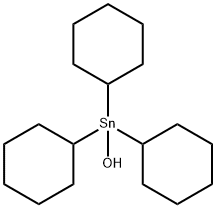
Cyhexatin
- русский язык имя
- английское имяCyhexatin
- CAS №13121-70-5
- CBNumberCB9682838
- ФормулаC18H34OSn
- мольный вес385.17
- EINECS236-049-1
- номер MDLMFCD00078642
- файл Mol13121-70-5.mol
| Температура плавления | 195-198°C |
| Температура кипения | 426.1±28.0 °C(Predicted) |
| давление пара | 3×10-7 Pa (20 °C) |
| Fp | >100 °C |
| температура хранения | 0-6°C |
| растворимость | Chloroform (Slightly, Heated, Sonicated) |
| форма | solid |
| Растворимость в воде | <1 mg l-1(25 °C) |
| пка | 6.76±0.70(Predicted) |
| Гидролитическая чувствительность | 4: no reaction with water under neutral conditions |
| Мерк | 13,2789 |
| Справочник по базе данных CAS | 13121-70-5(CAS DataBase Reference) |
| Рейтинг продуктов питания EWG | 3 |
| FDA UNII | 8YJV11QB4R |
| Предложение 65 Список | Cyhexatin |
| Система регистрации веществ EPA | Cyhexatin (13121-70-5) |
| Коды опасности | Xn;N,N,Xn,T |
| Заявления о рисках | 20/21/22-50/53-25-21-20 |
| Заявления о безопасности | 13-60-61-45 |
| OEB | B |
| OEL | TWA: 5 mg/m3 |
| РИДАДР | UN 2811 |
| RTECS | WH8750000 |
| TSCA | No |
| Класс опасности | 6.1(b) |
| Группа упаковки | III |
| Банк данных об опасных веществах | 13121-70-5(Hazardous Substances Data) |
| Токсичность | LD50 in adult male, female rats (mg/kg): 779, 826 orally (Gaines, Linder) |
рисовальное письмо(GHS)
-
рисовальное письмо(GHS)


-
сигнальный язык
опасность
-
вредная бумага
H301:Токсично при проглатывании.
H410:Чрезвычайно токсично для водных организмов с долгосрочными последствиями.
H312+H332:Вредно при попадании на кожу или при вдыхании.
-
оператор предупредительных мер
P261:Избегать вдыхания пыли/ дыма/ газа/ тумана/ паров/ аэрозолей.
P273:Избегать попадания в окружающую среду.
P301+P310+P330:ПРИ ПРОГЛАТЫВАНИИ: Немедленно обратиться за медицинской помощью. Прополоскать рот.
P302+P352+P312:ПРИ ПОПАДАНИИ НА КОЖУ: Промыть большим количеством воды. Обратиться за медицинской помощью при плохом самочувствии.
P304+P340+P312:ПРИ ВДЫХАНИИ: Свежий воздух, покой. Обратиться за медицинской помощью при плохом самочувствии.
P391:Ликвидировать просыпания/проливы/утечки.
Cyhexatin химические свойства, назначение, производство
Химические свойства
Cyhexatin is a colorless to white, nearly odor- less, crystalline powder.Использование
Cyhexatin is a derivative of tricyclohexyltin and an effective acaricide used in the control of spider mites.Общее описание
Technical Cyhexatin is a nearly odorless white crystalline powder that has no true melting point but degrades to bis(tricyclohexyl)tin oxide at 121 to 131°C which decomposes at 228°C; a melting point of 195-198°C is also reported. Very insoluble in water (less than 1 mg/L at 25°C), but wettable by water. Soluble in some organic solvents (acetone 1.3 g/L; xylenes 3.6 g/L; carbon tetrachloride 28 g/L; dichloromethane 34 g/L). Used as an acaricide (an agent to kill plant-feeding mites) in almonds, walnuts, hops and some fruits.Профиль реактивности
Cyhexatin is incompatible with strong oxidizing agents. Soluble in some organic solvents (acetone 1.3 g/L; xylenes 3.6 g/L; carbon tetrachloride 28 g/L; dichloromethane 34 g/L). Stable in aqueous suspensions in neutral and alkaline pH (above pH 6), but reacts exothermically as a base in the presence of strong acids to form salts. Converts to dicyclohexyltin oxide and further to cyclohexylstannoic acid upon exposure to ultraviolet radiation.Профиль безопасности
Poison by ingestion, inhalation, and intraperitoneal routes. Moderately toxic by skin contact. Experimental reproductive effects. When heated to decomposition it emits acrid smoke and irritating fumes. See also TIN COMPOUNDS.Возможный контакт
Used as an agricultural chemical and pesticide. A potential danger to those involved in the manu- facture, formulation, and application of this acaricide (miticide).Метаболический путь
There is little published information of the degradation and metabolism of cyhexatin. However, useful information on the fate of cyhexatin in a water/sediment system can be deduced from published data on azoc yclotin.Перевозки
UN2786 Organotin pesticides, solid, toxic, Hazard Class: 6.1; Labels: 6.1-Poisonous material. UN2811 Toxic solids, organic, n.o.s., Hazard Class: 6.1; Labels: 6.1- Poisonous materials, Technical Name Required.Несовместимости
Incompatible with strong oxidizers. May react exothermically as base in the Incompatible with strong oxidizers. May react exothermically as base in the Incompatible with strong oxidizers. Reacts exothermically as base in the presence of strong acids, forming salts. Keep away from ultraviolet radiation which may cause conver- sion to dicyclohexyltin oxide and further to cyclohexylstan- noic acid .Cyhexatin запасные части и сырье
Cyhexatin поставщик
| поставщик | телефон | страна | номенклатура продукции | благоприятные условия |
|---|---|---|---|---|
| 18871490254 | CHINA | 28172 | 58 | |
| 86-13657291602 | CHINA | 22963 | 58 | |
| +86-023-6139-8061 +86-86-13650506873 |
China | 39894 | 58 | |
| +8618523575427 | China | 49732 | 58 | |
| +86-0371-86658258 +8613203830695 |
China | 29809 | 58 | |
| +86-29-87569266 15319487004 |
China | 3939 | 58 | |
| +86-592-5360779 +86-13055435203 |
China | 5988 | 58 | |
| +86-0512-83500002 +8615195660023 |
China | 23046 | 58 | |
| +86-371-86557731 +86-13613820652 |
China | 20259 | 58 | |
| +1-+1(833)-552-7181 | United States | 57505 | 58 |